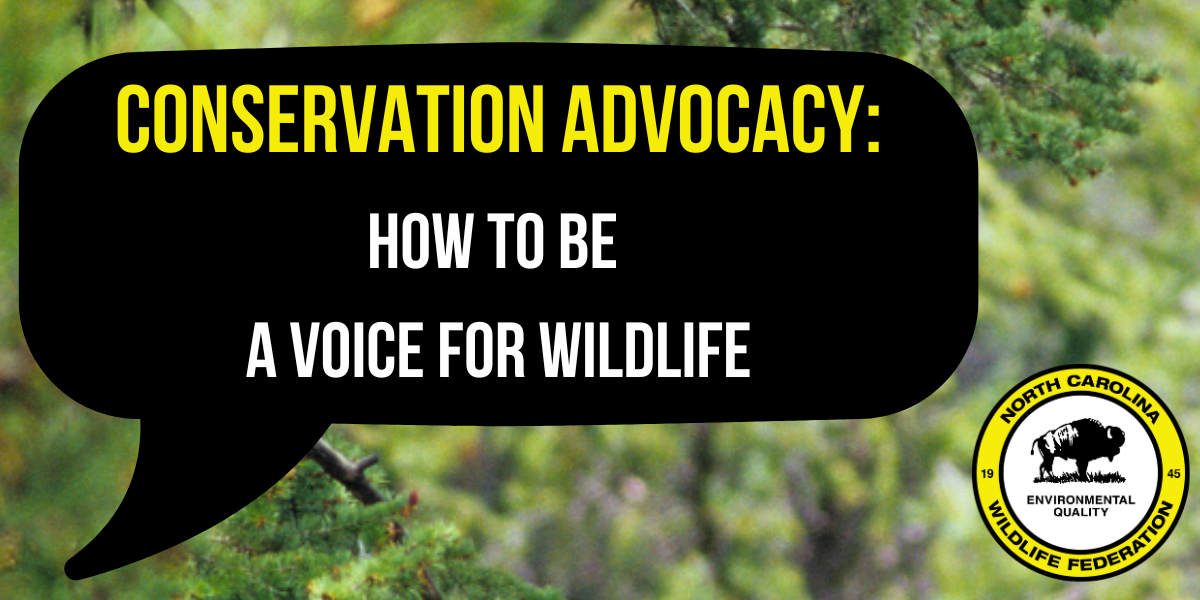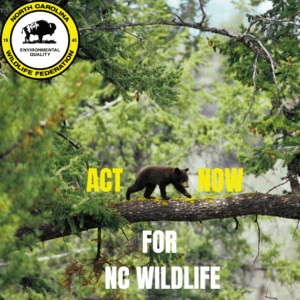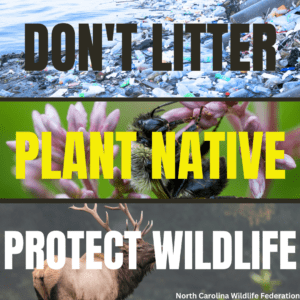Conservation Advocacy: How to Be A Voice for Wildlife

Engaging in and strongly influencing local, state, and federal policy that affects wildlife and habitat in North Carolina is one of NCWF’s top strategies. It goes without saying that this organizational commitment is not a small one, particularly given NCWF’s dedication to using science-based, established conservation models to guide the organization’s positions on policy and action.
But this is the way that real, positive change is made for wildlife and habitat – and it takes a community! Advocacy does not function well in fragments or in isolation, and strong policy decisions can only take place with community support. Which is why we need your help to take a stand for wildlife and habitat!

NC Representative and Legislator of the Year Kyle Hall
NC Representative Kyle Hall is on the front lines of such advocacy. As the winner of the Legislator of the Year Award at the Governor’s Conservation Achievement Awards, he exemplifies what it means to be a voice for wildlife – and encourages others on all sides of the political spectrum to do the same.
“North Carolina is blessed with an abundance of natural resources, fish and wildlife. If the Covid shutdowns taught us anything, it’s that our citizens want outdoor recreational opportunities.” Said Representative Hall, “That’s why we’ve seen such an uptick in visitation to our state parks, trails and forests. Advocating for resources like this for our state not only provides outdoor opportunities, but it also preserves land, including farmland, in our booming state. The legislature is a perfect example of why it takes a community to succeed. We’re all elected from different areas of our state with different backgrounds. We all have different political and ideological differences, but we have to come together to find common ground to make the best decisions for North Carolina.”
As noted by Representative hall, impactful advocacy requires moving past political differences to be a collective voice for the voiceless.
Below are a few simple things you can do to affect change in policies that directly impact wildlife and habitat in your own backyard – and across the state.
Stay Educated
As an advocate for wildlife and habitat, stay informed on policies that are currently in place, being considered, or are likely to emerge in the future.
In order to understand what policies are necessary and what systems should be set in place, understand the risks to wildlife in North Carolina such as:
- Inshore shrimp trawling kills millions of juvenile fish and other wildlife and destroys the seagrass habitat that these species need to grow and thrive. For every pound of shrimp harvested in North Carolina sounds and estuaries, four pounds of “bycatch” is discarded. That’s 30 million pounds of dead sea life in a year.
- Wild red wolves can only be found in North Carolina on the Albemarle Peninsula and are one of the most endangered canids in the world. Saving the species requires knowledge of the Red Wolf Recovery Program, and the practices already in place that are working to ensure their survival.
- Monarch butterflies (among other pollinators) face worldwide distress as a result of increased pesticide use, habitat loss, and diminishing food sources – such as milkweed. Wildlife-friendly policies and legislation – including Recovering America’s Wildlife Act – aim to directly address these issues, and need community support in order to succeed!
Sometimes staying in the know on these topics is difficult, especially considering the abundance of false or biased information out there. However, there are some science-based sources that you can trust to learn about issues affecting wildlife, and the policies in place and proposed to protect them.
Resources:
- North Carolina Wildlife Federation blog postings and email alerts.
- North Carolina Wildlife Resources Commission
- U.S. Fish and Wildlife Service
If you ever have any questions about a current issue facing wildlife, feel free to reach out to communications@ncwf.org.
Take Action Through Action Alerts and Petitions
 One of the best ways to ensure that your voice is heard is by raising your voice with other conservationists and wildlife supporters across the state.
One of the best ways to ensure that your voice is heard is by raising your voice with other conservationists and wildlife supporters across the state.
Action alerts are a great way to vocalize your support for a wildlife bill, speak out against harmful systems and practices, stand up to special interests, and encourage your representatives to act. And here’s the best part about action alerts: they ensure that your message goes right to your political or organizational representative.
You can sign up for NCWF action alerts to get breaking news on wildlife policy happenings, particularly opportunities for you to raise your voice for wildlife straight to the representatives that can implement large-scale action.
The nice thing about action alerts is that they typically only take a couple of minutes to complete, allow for message customization, and are easily shareable with like-minded wildlife supporters in your own community!
Advocate on Social Media
Social media has a variety of uses, but one of the things it does best is reach a captivated, large audience, quickly.
While this can certainly be a problem – particularly when people spread misinformation that still gains social traction – it can be a constructive tool when raising awareness about genuine issues.
The best way to use social media as an advocacy tool is through concise, noninflammatory, purpose-driven communication. Staying concise with your information helps to clearly convey your message without room for misinterpretation or confusion. Social media is not a great medium for long-form content – and most people only linger on your post for a few seconds at most, anyway – so remember to keep it simple.
In today’s polarized world where any kind of information is likely to upset others and bring about a debate of some kind, it is best to steer clear of any inflammatory language or verbal attacks . The best kind of messaging is passionate without being aggressive, direct without being offensive. Good communication has the power to change minds, but not at the cost of burning bridges.

It goes without saying that your message is improved and better received when using correct grammar and aesthetic appeals. In other words, make your content interesting and make it look good! You don’t have to have extensive training in photo editing, newswriting, or graphic design to make this happen.
Here are a few easy to use online tools that can help you create some advocational wildlife and habitat centered pieces:
You can try your hand at content creation on Canva. Canva is great for generating posters, flyers, social media appeals, and more. It’s super user-friendly and has a great free version!
Adobe Photoshop (and its sister platform, Adobe Lightroom), while not quite as user-friendly as Canva, is a very flexible photo-editing/design platform that allows for increased customization.
Finally, don’t underestimate the power of editing tools in social media platforms, themselves. Facebook and Instagram both allow for some basic photo editing options, including text overlay – which allows you to write a message over whatever image you would like.
Make sure to follow NCWF on Facebook and Instagram, and tag us in your post so that we can reshare your message.

– Written by Bates Whitaker, NCWF Communications & Marketing Manager

